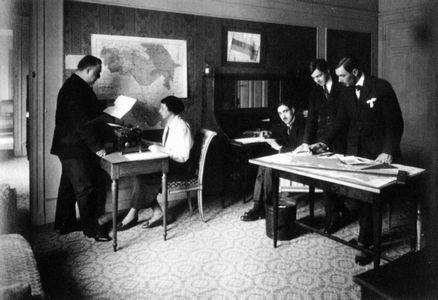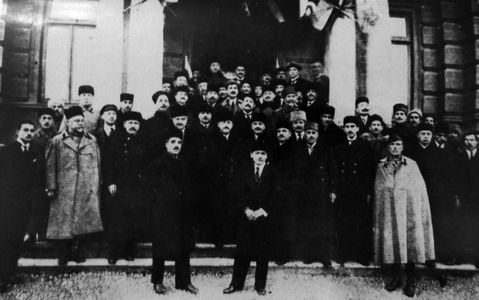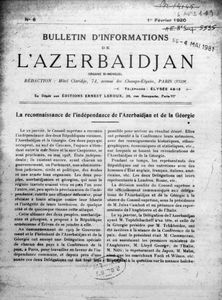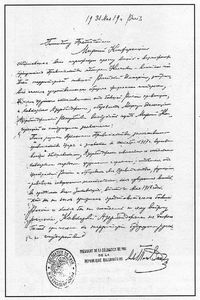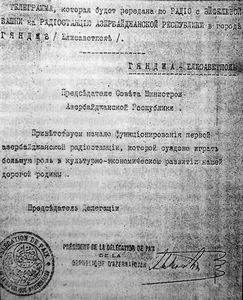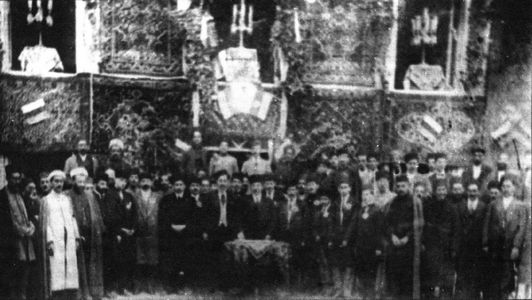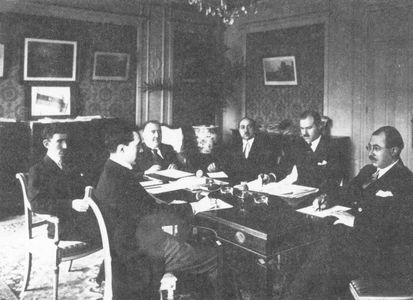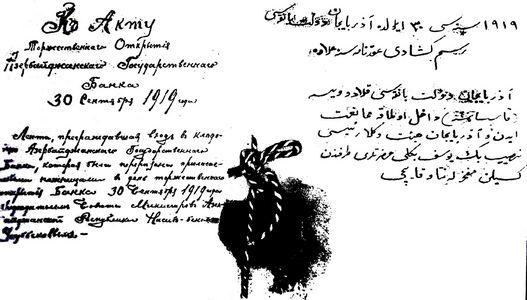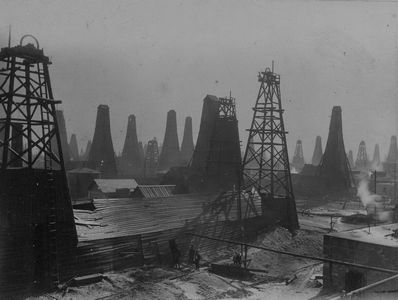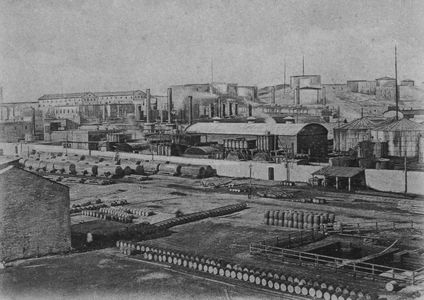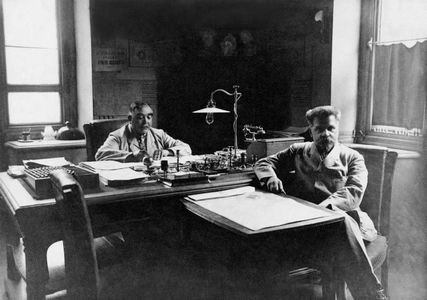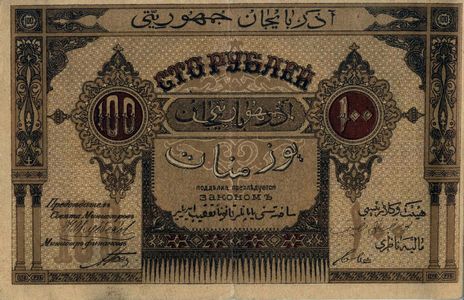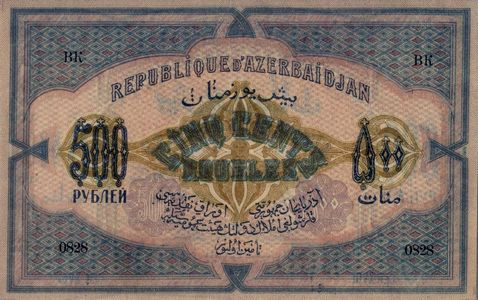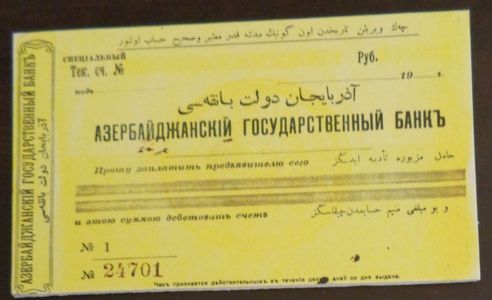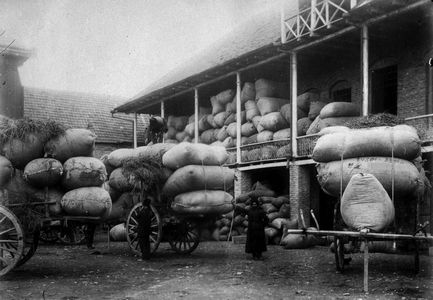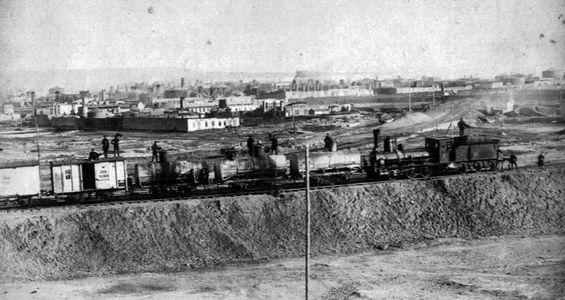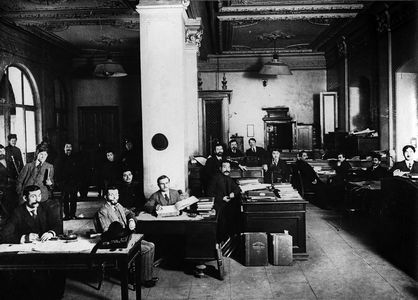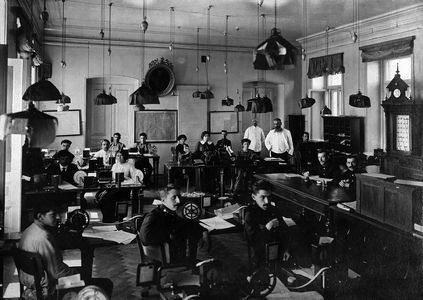The foreign policy of the Azerbaijan Republic
The state body that implemented the foreign policy of the Azerbaijan Republic was the Ministry of Foreign Affairs (MFA). One of the main challenges faced by the government of the republic and its Foreign Ministry was to achieve recognition of the republic by the leading states of the world.
Diplomatic representative offices of foreign countries in Azerbaijan.
By April 1920, there were diplomatic representative offices of Georgia and Armenia, a consulate general of Iran, consulates of Belgium, the Netherlands, Greece, Sweden, Italy, Denmark and Switzerland, vice-consulates of Great Britain, the USA and Ukraine, consular agents of France, Lithuania, Poland and Finland in Baku. The Japanese government expressed its readiness to open a diplomatic office, and the Vatican sent its representative to Baku.
Diplomatic representative offices of Azerbaijan in foreign countries.
The Azerbaijan Republic had diplomatic representative offices in Istanbul (the Ottoman Empire), Tehran (Iran), Tbilisi (Georgia), Iravan (Republic of Armenia), the Kuban and Don government, Turkestan, at the Paris Peace Conference, as well as consulates-general in Batumi (Republic of Georgia), Kiev (Ukraine), Tabriz (Iran), consular agents in the Crimea, Port-Petrovsk (Mountain Republic), Anzali, Khoy, Rasht and Ahar (all in Iran), and a vice-consul in Mashhad (Iran). From 1 April 1920, it was planned to open diplomatic missions of Azerbaijan in France, Great Britain, Switzerland, Italy, USA, Germany, Poland and Soviet Russia.
Azerbaijan's agreements with foreign countries.
The Azerbaijan Republic had signed a number of agreements with foreign states: a Treaty of Friendship with the Ottoman Empire (4 June 1918, Istanbul); an agreement with Georgia and the Ottoman Empire on ensuring the normal functioning of the Baku-Batum kerosene pipeline (4 June 1918, Batum); an agreement with Georgia and Armenia on the issue of Transcaucasian monetary unit (6 September 1918, Batum); the first agreement with the Mountain Republic (28 November 1918); an agreement with Georgia on the supply of goods (26 December 1918, Baku); an agreement with Georgia on telegraphy (3 January1919, Tbilisi); an agreement with Georgia on the postal service (4 January 1919, Tbilisi); a convention with Georgia on the carriage of postal goods by rail (1 April 1919, Tbilisi); a second agreement with the Mountain Republic (9 January 1919); a third agreement with the Mountain Republic (23 February 1919); a military defence pact with Georgia (16 June 1919, Tbilisi); an agreement with Georgia on military-technical cooperation (16 June 1919, Tbilisi); an agreement on peace with Iran (20 March 1920, Tehran); a convention with Iran on trade and customs matters; an agreement on the post with Iran; an agreement on telegraphy with Iran (20 March 1920, Tehran); a convention on consulates with Iran (20 March 1920, Tehran).
The recognition of Azerbaijan by leading countries of the world.
The first country to recognize the independence of the Azerbaijan Republic was the Ottoman state (4 April 1918).
In December 1918, the parliament of the Azerbaijan Republic made a decision to send a delegation with a broad mandate to participate in the Paris Peace Conference. Talks at the conference could be of vital importance to Azerbaijan. Therefore, the head of the delegation was the chairman of the parliament, Alimardan Topchubashov. The delegation had the following composition: A.M. Topchubashov (chairman), M.H. Hajinski (deputy chairman), A. Aghayev, A. Sheykhulislamov, M. Maharramov, M.Y. Mehdiyev and J. Hajibayli (advisor). The delegation included several secretaries and interpreters. After three months of waiting, the delegation went to Paris. In autumn 1919, A. Atamalibayov joined the delegation.
On 11 January 1920, the Azerbaijan Republic was recognized de facto by the leading states of the world – participants in the Paris Peace Conference. At the solemn session of the parliament (14 January 1920) dedicated to this event, Fatali Khan Khoyski said: "... It is a great holiday not only for us but for the whole Turkic world. In order to achieve this, other nations tried and acted for decades. We achieved this in a year and a half."
On 20 March 1920, the independence of the Azerbaijan Republic was recognized de jure by Iran.
The economic development of Azerbaijan
1918-1920
"The root of intellectual, national and political independence
is economic independence"
Mahammad Emin Rasulzadeh
By the time the independence of Azerbaijan was proclaimed, the country's economy was in a state of ruin. The consequences of World War I, the genocide of Azerbaijanis, the predatory activity of the Baku Council and the Centro-Caspian Dictatorship and the arbitrariness of foreign troops brought the economy to the brink of disaster. The government of the Azerbaijan Republic carried out significant measures in the cause of economic construction.
Confiscated and nationalized industrial, commercial and financial enterprises and vehicles were returned to their former owners and laws aimed at protecting business were passed, which contributed to the accelerated economic recovery. The oil industry was led out of the crisis, the destroyed Baku-Batum oil pipeline was restored, national currency was released and inflation was stopped.
Transport as a whole was restored. The construction of the Baku-Julfa railway continued and a bridge over the Kur River was built. Four pairs of trains travelled on each Baku-Batum and Baku-Port-Petrovsk (Makhachkala) routes a day . The Baku trade port was restored, and 17 large steam ships of the Caspian Shipping Company and 10 ships on the Kur River were put into operation. The work of the Baku car repair plant was restored.
The national financial system was established with great difficulty. In the autumn of 1918, money known as "Baku cheques" was put into circulation. Along with this currency at that time tsarist money ("Nikolayevka"), the Provisional Government money ("Kerenska"), Transcaucasian cheques were in circulation. From the beginning of 1918, the government began to issue national currency. During 1919, paper money was issued in denominations of 25, 50, 100 and 250 manats and in early 1920, 500 manats. On 20 August 1919, the Baku Municipal Board issued premium bonds with the permission of the government. In October 1919, 12 national and 70 local banking offices and 200 local lending institutions were opened.
First of all, the Azerbaijan Republic established the Ministry of Commerce, Industry and Food. The Ministry of Agriculture and State Property managed agriculture, material resources and property. The Ministry of Labour, founded on 21 January 1919, regulated labour relations and related processes.
The Ministry of Finance was the authority that managed the organization and regulation of the financial system of the state. The Customs Service was created in the republic. In June 1919, the Ministry of Finance established a department overseeing customs duties. The Border Service was also subordinate to the ministry, and 992 border guards served at 99 crossing points.
In the cause of implementing the financial policy of the Azerbaijan Republic, an important role belonged to the Azerbaijan State Bank (ASB) created on 7 March 1919. The grand opening of the ASB took place on 30 September. The goal of the ASB was to simplify money matters, help national trade, industry and agriculture, as well as strengthen the monetary system. At the time of establishment, the initial capital was 500 million roubles and reserve capital - 20 million. The Bank had the exclusive right to issue national currency. The ASB was governed by a council of bankers. Also, there were private banks in Azerbaijan such as the Baku Merchants Bank, the Baku Persian Bank, the Baku branch of the Tiflis Merchants Bank, and others.
The Azerbaijan Exchequer Chamber, the important government agency in the financial system of the Azerbaijan Republic was in charge of collecting tax revenues.

